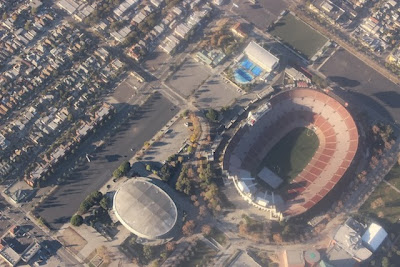I hadn't planned on this order of the pictures, but when I looked at them, these two seemed so similar (long flat foreground, looking into the light) that they seemed a perfect pairing. And a perfect contrast between the two worlds we've been bouncing back and forth between, as we visit my mom each month.
I've always been fascinated by how easy it is today to walk through a door in an airport in one part of the world and walk out another door into another part of the world. I remember walking through the Brussels airport and seeing (to me) exotic African cities listed at the gates. And the contrast between Anchorage and LA in January is pretty stark.
I contrast this with the ten days (in my memory anyway) it took to sail from New York to Le Havre in 1964 on the way to spending a college year in Germany. Or to driving from Anchorage to Boston and back. Overland (or oversea) one has time to feel the distance. One's body has time to adjust to waking up closer or further from the sunrise. One's brain has time to process the land or sea scape. But planes abruptly fling one from one point on earth to another. That's one reason I like window seats - so I can, when it's clear and light - get some sense of the topography I'm traveling through.
OK, enough musing. Here are some shots as we got to enjoy the dawn. (A positive side of the shorter days in Anchorage is that even people who sleep late get to see the dawn.)
 |
| Just off the plane in LAX terminal 6 |
 |
| Still dark waiting for the shuttle to the bus station |
 |
| Just starting to get light as we get to the bus station |

We then slept for half the day.
[Photo notes:I didn't bring the bigger camera on this trip. Our flights are both in the dark, so no landscape shots, and I'm trying to travel as light as I can. It would have been nice to have the polaroid filter Joe Blow suggested in comments to an early post, so the Good Bus Karma didn't have all the reflection. I could have just cropped the picture to that sign, but I wanted the sense of being on the bus as well. So I stretched the crop to keep the word bus and I included the driver and steering wheel. The palm trees outside were pretty washed out, so I did play with brightness in photoshop for that part.]













































